 |
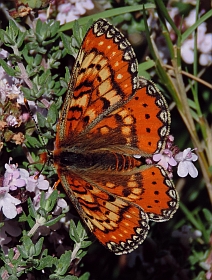 Spanish Fritillary
Spanish Fritillary
Euphydryas desfontaini© Teresa Farino
Moon Moths and Monkey Orchids
Our base in Navarra is home to fabulous Spanish Moon Moths, many unusual spring butterflies, a plethora of orchids and a good selection of charismatic birds. Macro photo opportunities galore!
All the images on this page were taken during previous May trips to this part of Navarra.
Pamplona is situated at the heart of a mosaic of semi-natural grasslands and maquis on calcareous marls, interspersed with extensively farmed cereal fields, copses of deciduous forest and pinewoods. Although it lies only 80 km from the Atlantic coast of Spain, with the Pyrenees just a stone’s throw to the north-east, this part of Navarra benefits from a warm, almost Mediterranean climate, giving rise to a unique assemblage of flora and fauna, quite unlike that found anywhere else in Spain.
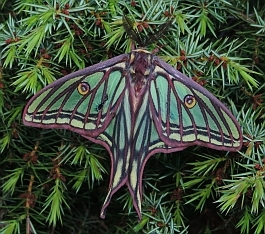 Spanish Moon Moth Actias isabellae© Teresa Farino
Spanish Moon Moth Actias isabellae© Teresa Farino
Undoubtedly the most famous inhabitant of the region – and our prime target species – is the Spanish Moon Moth (Actias isabellae, formerly known as Graellsia isabellae), perhaps Spain’s most emblematic invertebrate. One of just a handful of European members of the Saturniidae, it occurs only in pinewoods in the western Alps and central and eastern Spain. As might be expected, our visit is timed to coincide with the peak flight period of these magnificent creatures in Navarra, and we shall locate them using light traps.
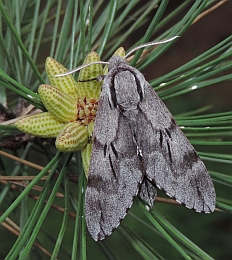 Southern Pine Hawkmoth
Southern Pine Hawkmoth
Hyloicus maurorum© Teresa Farino
Other moths of interest that have come to our lights at this time of year include Giant Peacock (Saturnia pyri), Small Lappet (Phyllodesma ilicifolia; nowadays extinct in the UK), The Javelin (Drymonia velitaris), Southern Pine Hawk-moth (Hyloicus maurorum) and geometrids such as The Many-lined (Costaconvexa polygrammata) and Essex Emerald (Thetidia smaragdaria), both of which are also thought to be extinct in the UK, plus Pale-banded Pine Carpet (Adalbertia castiliaria, another pine-feeding species, found only in southern France and Spain). Species known mainly in the UK as migrants but commonly seen in the valley include Tawny Wave (Scopula rubiginata), Porter's Rustic (Athetis hospes) and Marbled Clover (Heliothis viriplaca).
Additional species of note previously recorded in the valley include Bright Wave (Idaea ochrata), Pine-tree Lappet (Dendrolimus pini), the endemic Iberian Puss Moth (Cerura iberica), Argentine Moth (Spatalia argentina), Emperor Moth (Saturnia pavonia), the endemic tiger moth Chelis arragonensis, Purple Tiger (Rhyparia purpurata) and the extremely rare and endangered Willowherb Hawk-moth (Proserpinus proserpina).
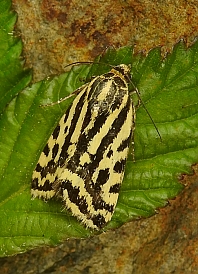 Spotted Sulphur Emmelia trabealis© Teresa Farino
Spotted Sulphur Emmelia trabealis© Teresa Farino
Among the notable day-flying species here in May are White-collared Burnet (Zygaena lavandulae), Crowned Moth (Eurranthis plummistaria), Serrated Jewel (Athroolopha pennigeraria), The Four-spotted (Tyta luctuosa and Spotted Sulphur (Emmelia trabealis), the latter probably extinct in the UK these days, the dinky little noctuid Omia cymbalariae and both Broad- and Narrow-Bordered Bee Hawk-moths (Hemaris fuciformis & H. tityus).
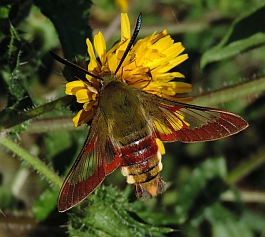 Broad-bordered Bee-hawk
Broad-bordered Bee-hawk
Hemaris fuciformis© Teresa Farino
The butterflies are equally beguiling in this part of Navarra, the undisputed highlight being several colonies of Spanish Fritillary (see image at the top of the page), essentially an Afro–Iberian endemic species with a few outlying colonies in southern France. Other species of interest here include Sage Skipper, Provence Orange Tip, Duke of Burgundy Fritillary and lycaenids such as Green-underside and Panoptes Blues, as well as, surprisingly, good numbers of Chalk-hill Blues. One short walk we undertake during the week should reward us with literally hundreds of Swallowtails, Scarce Swallowtails and Spanish Festoons.
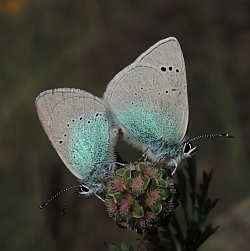 Green-underside Blues
Green-underside Blues
Glaucopsyche alexis© Teresa Farino
Such a rich lepidopteran fauna is of course indicative of a diverse flora, with special mention going to a veritable ‘zoo’ of orchids in flower in May: Lizard, Monkey, Lady, Man, Lesser Butterfly, Woodcock, Early Spider and many more. The delightful Thalictrum tuberosum, Coris, Beautiful Flax, Meadow Clary, lemon-yellow Phlomis lychnitis, Blue Aphyllanthes and Grape-hyacinth provide a riot of colour on sunny slopes, while shady nooks are brightened by Yellow Pheasant’s-eye, Columbines and Dragon’s-teeth, and the diminutive scarlet Pheasant’s-eye grows in the margins of cultivated fields.
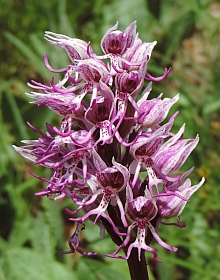 Monkey Orchid Orchis simia© Teresa Farino
Monkey Orchid Orchis simia© Teresa Farino
Among the birds we might encounter in the grassland–scrub mosaic are Fan-tailed Warbler, Nightingale, Red-backed Shrike, Cuckoo, Spotless Starling and Cirl and Corn Buntings, with Iberian Woodpecker, Bonelli’s Warbler and Short-toed Treecreeper in more wooded habitats. On sunny days the skies above are rarely empty, with Griffon Vultures and Red and Black Kites the most commonplace raptors here.
 Bardenas Reales© Teresa Farino
Bardenas Reales© Teresa Farino
One day during the week we will venture south to the magnificent gypsum pseudosteppes and ‘badlands’ of the Bardenas Reales Biosphere Reserve. Against a stunning backdrop of eroded cliffs – home to breeding Egyptian Vulture, Golden Eagle, Peregrine, Eagle Owl, Alpine Swift and Black Wheatear – we shall endeavour to track down Spanish Marbled White, Southern Marbled Skipper and Western Dappled and Bath Whites, as well as day-flying moths such as the Catalan Yellow (Narraga catalaunica), an Iberian endemic geometrid, and the striking crambid Loxostege comptalis.
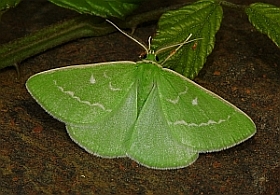 Essex Emerald Thetidia smaragdaria© Teresa Farino
Essex Emerald Thetidia smaragdaria© Teresa Farino
Birdwise, we should look out for Bee-eaters and Hoopoes at close quarters, Spectacled Warblers nesting in the low scrub, and a plethora of larks and pipits in more open areas, including Tawny Pipit and Calandra Lark; if we’re really lucky we might catch a glimpse of a Dupont’s Lark, of which around 400 pairs are known to breed here. Other species typical of the Bardenas Reales include Booted and Short-toed Eagles, Montagu’s and Marsh Harriers, Stone Curlew and both Pin-tailed and Black-bellied Sandgrouse, although the Little and Great Bustards that breed here are pretty scarce nowadays.
NB For the duration of the tour, you will be covered by Teresa's permits both to catch butterflies and trap moths (a legal requirement for Spain). All the Lepidoptera records we collect will be submitted to Zerynthia (the Spanish partner of Butterfly Conservation).
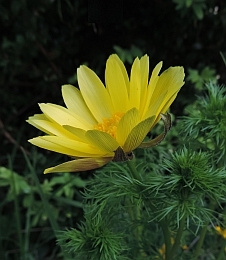 Yellow Pheasants-eye Adonis vernalis© Teresa Farino Yellow Pheasants-eye Adonis vernalis© Teresa Farino
Moon Moths and Monkey Orchids
Leader: Teresa Farino
2019 Dates: Mon. 27 May – Sun. 2 June (7 days/6 nights)
Price: 1,300€, including half-board, en suite accommodation at Hotel Izaga, picnic lunches, minibus/4WD transport throughout, all entry fees and the services of Teresa Farino as leader. A single-room supplement of 135€ is applicable. Flights and travel insurance (obligatory) are the responsibility of the client.
Although the cost of the tour is given in euros, clients may pay in sterling, the exchange rate to be calculated at the time of payment using www.oanda.com
Pick-up details: For this tour, clients will be booking their flights to Bilbao independently. British Airways and Vueling fly to this destination from London Gatwick, and easyJet from London Stansted on these dates, although the times are not ideal. Teresa will be collecting clients from Bilbao at 11.00 on 27 May, and returning to the same airport by 14.30 on the 2 June, in order to accommodate all options.
Alternatively, those travelling to Navarra independently can arrange to meet the group at Hotel Izaga on the first evening.
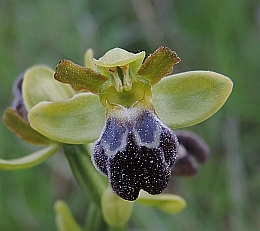 Sombre Bee Orchid Ophrys fusca© Teresa Farino Sombre Bee Orchid Ophrys fusca© Teresa Farino
If you wish to extend your visit in order to explore Spain further, please remember that if you require transport to the hotel you must arrange to be at Bilbao airport by 11.30 am at the latest on Monday 27 May.
Group size: maximum 8 persons.
Booking information: please contact Teresa Farino for further details and a booking form, or if you have any queries about this tour.
| E-mail: |
|
|
| Office phone: | (+34) 942 735154 |
| Mobile phone: | (+34) 656 337129 |
|
| Address: |
Apartado de Correos 59
39570 Potes
Cantabria
Spain
|
|